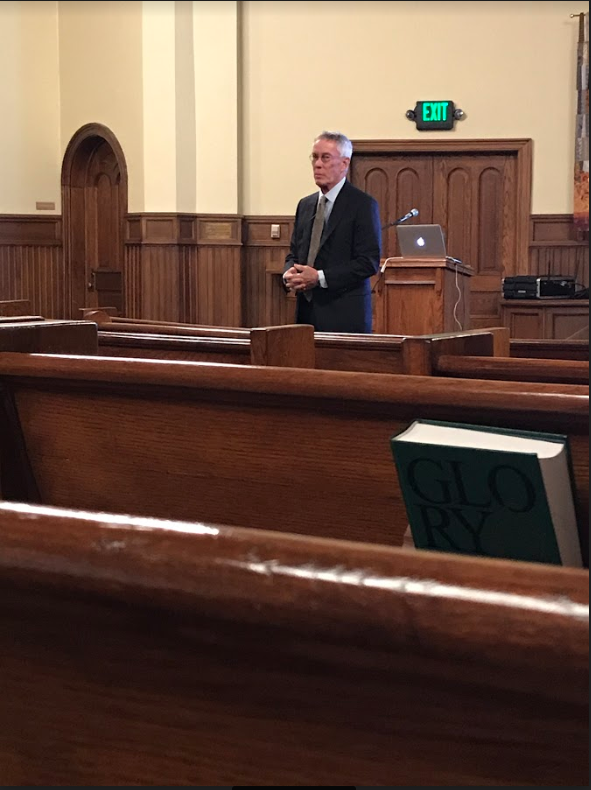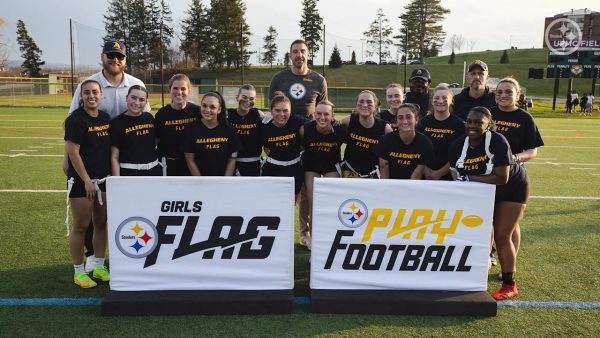Robert Glennon visits campus for a second time, gives lecture on safety of lettuce
University of Arizona Professor Robert Glennon gives his lecture, titled “Eating Lettuce: Is it Safe?” on Wednesday, Oct. 23 in Ford Memorial Chapel.
Ever since the outbreak of E. coli caused by romaine lettuce in 2017, the safety of eating lettuce has been a concern in the United States. This concern is reflected in a new research project being done by University of Arizona Regents Professor and Morris K. Udall Professor of Law and Public Policy Robert Glennon.
Glennon was awarded an environmental prize from Allegheny in 2018 and came to campus to give a public lecture about his water research.
“He liked Allegheny so well that we decided to invite him back,” Associate Professor of Geology Rachel O’Brien said in her introduction of Glennon. “He’s here to talk about a new research project he’s been working on, the title of his lecture being ‘Eating Lettuce: Is it Safe?’”
Glennon began his presentation by discussing food safety and the first woman to get sick with E. coli from romaine lettuce in 2017. After the E. coli outbreak began, the Food and Drug Administration traced the disease back to lettuce from Yuma, Arizona, according to Glennon.
“More than 90% of the country’s lettuce comes from Yuma,” Glennon said. “During (the winter months), it comes from California.”
Glennon discussed how climate change affects the world’s water supply and how farmers must now use a larger amount of water to produce the same amount of food. Climate change causes many other problems that involve water, including in dams. Glennon used Oroville Dam in California as a specific example.
“This is a dam that almost broke in 2017 because of large unexpected snow melt,” Glennon said. “What does that mean? It means that in America, there are dams that are meant to store a certain amount of snow melt (and) were sized for a hydrologic regime that no longer exists.”
Glennon connected the problem of snow melt back to Yuma, Arizona, through the Colorado River, saying that in certain large agricultural areas there is no longer any water in parts of the river. To restore water supply to those areas, farmers in Yuma moved away from growing the typical iceberg lettuce to growing “baby lettuce.”
With the growing of this new lettuce comes new ways of producing it, according to Glennon. Glennon connected this to food safety and the different ways producers have tried to keep their lettuce healthy and safe for consumers to eat.
“Here’s the problem with lettuce: It’s grown outdoors,” Glennon said. “Most food (that people eat) has been sterilized or pasteurized, so it will be pure. There is no kill switch for something that you’re going to eat raw.”
Glennon showed the audience a short clip of a lettuce processing plant and described each step that processors had to take to ensure the lettuce was clean and healthy enough for consumption.
The steps included chilling the lettuce to keep the cells alive and prevent wilting, sending the lettuce through a processor to the washer, where it was washed multiple times, and then to a spinner for an additional check to get rid of most of the bad bacteria.
Glennon then moved discussion to how the FDA traced the E.coli infected lettuce back to Yuma. He used a pathway chart to help explain to the audience the multiple steps of the complicated process.
“It’s just like something from CSI,” Glennon said. “So imagine in all the TV shows you see, you have a police detective that’s trying to figure out a serial killer. They start putting pins on the map, where the killer was, and who the victims were. They’re trying to puzzle out all of this information, trying to figure out exactly what happened. Well, that’s exactly what (the) FDA does.”
Glennon then described the second outbreak of E.coli that occurred, saying that it was originally thought to have been caused by cow manure getting into the water system where the lettuce was grown. When scientists went and checked, they did not find the E.coli there.
“The FDA tested the soil and they tested the manure, and they didn’t find anything,” Glennon said. “They didn’t find any reason (how) it got there. … The FDA was not able to say conclusively that it came from the cows or this particular farm. All they could say was that it came from Yuma.”
Glennon described how the big businesses and fast food places like McDonald’s and Panera Bread did not care about where it came from or who was originally to blame for the outbreak. He used an example of if someone tried to sue Ford Motor Company for bad breaks, and Ford tried to push it off onto the company that made the breaks. According to Glennon, Ford would still get in trouble.
“The rules that are happening when it comes to food safety are coming from those who have the most to lose,” Glennon said. “And the places that have the most to lose are places like McDonald’s, Costco, Walgreens — those are the ones that have the most to lose.”
Glennon ended his lecture by telling the audience that although it is hard to stop the sickness because of many factors, that does not mean people should stop eating lettuce, rather to just decide the best place to buy lettuce.
“I think we have to live with a certain amount of ambiguity and risk,” Glennon said. “And we don’t like that at all. We expect perfection. … But when you’re eating something that’s been grown outdoors and hasn’t been cooked, perfection is a pipe dream. … I think you’re more likely to get struck by lightning (then to get sick from lettuce), but there is a small chance, and it is real.”

Sara Holthouse is a senior from Panama, NY. This is her third year/final semester on staff, where she has previously served as news editor for the past...







